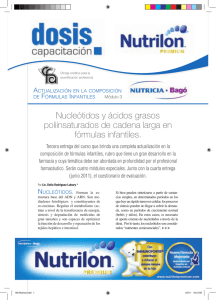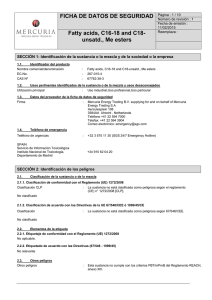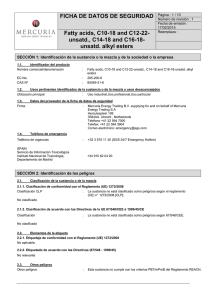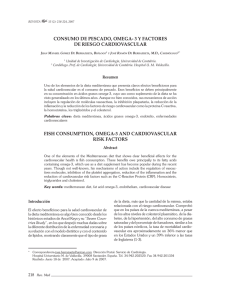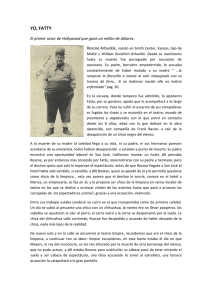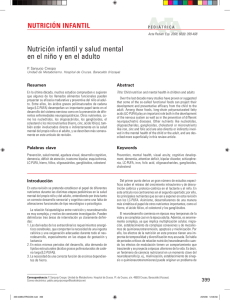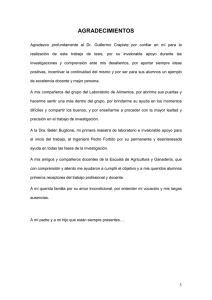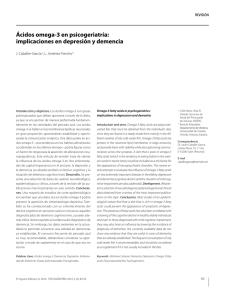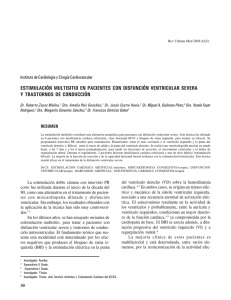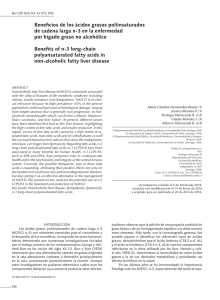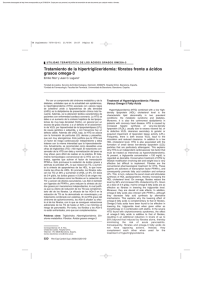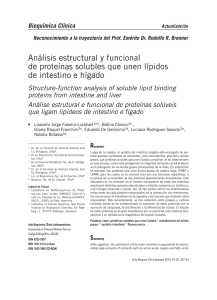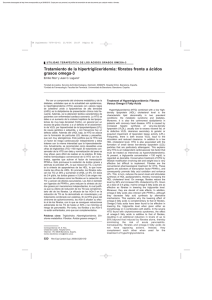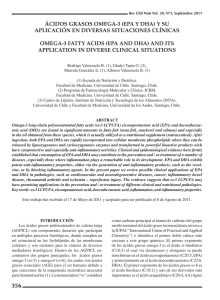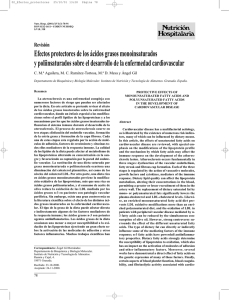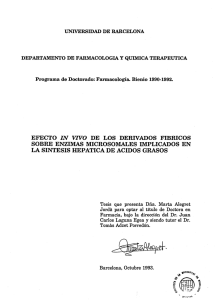BibliogrfiaPezzutti.pdf
Anuncio
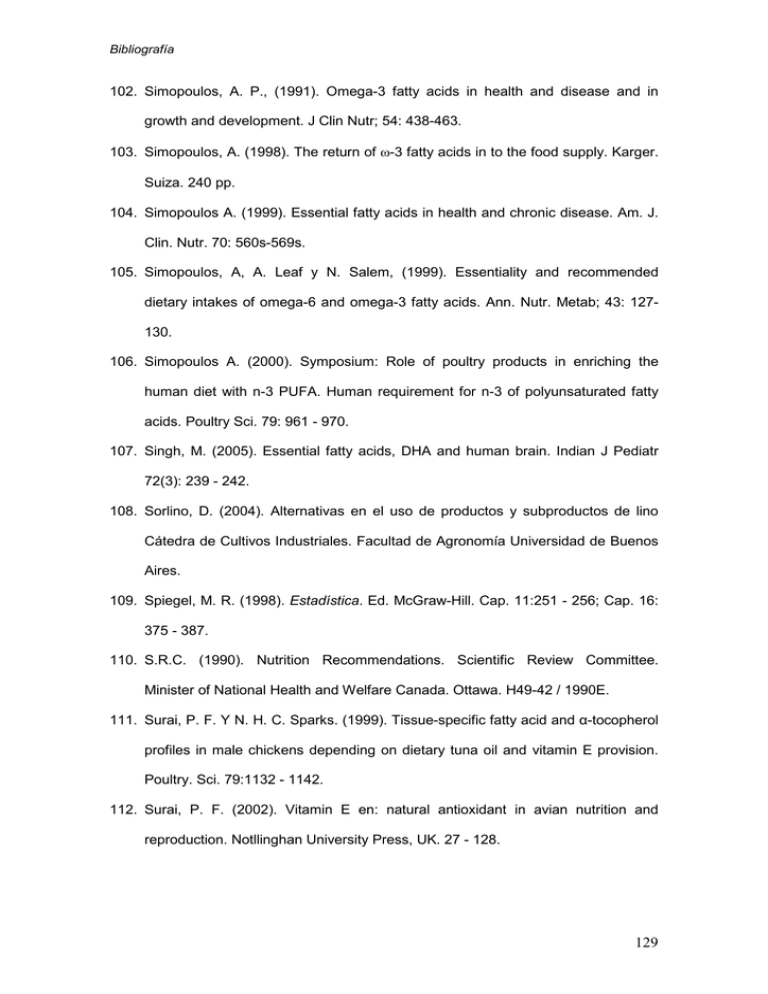
Bibliografía 102. Simopoulos, A. P., (1991). Omega-3 fatty acids in health and disease and in growth and development. J Clin Nutr; 54: 438-463. 103. Simopoulos, A. (1998). The return of ω-3 fatty acids in to the food supply. Karger. Suiza. 240 pp. 104. Simopoulos A. (1999). Essential fatty acids in health and chronic disease. Am. J. Clin. Nutr. 70: 560s-569s. 105. Simopoulos, A, A. Leaf y N. Salem, (1999). Essentiality and recommended dietary intakes of omega-6 and omega-3 fatty acids. Ann. Nutr. Metab; 43: 127130. 106. Simopoulos A. (2000). Symposium: Role of poultry products in enriching the human diet with n-3 PUFA. Human requirement for n-3 of polyunsaturated fatty acids. Poultry Sci. 79: 961 - 970. 107. Singh, M. (2005). Essential fatty acids, DHA and human brain. Indian J Pediatr 72(3): 239 - 242. 108. Sorlino, D. (2004). Alternativas en el uso de productos y subproductos de lino Cátedra de Cultivos Industriales. Facultad de Agronomía Universidad de Buenos Aires. 109. Spiegel, M. R. (1998). Estadística. Ed. McGraw-Hill. Cap. 11:251 - 256; Cap. 16: 375 - 387. 110. S.R.C. (1990). Nutrition Recommendations. Scientific Review Committee. Minister of National Health and Welfare Canada. Ottawa. H49-42 / 1990E. 111. Surai, P. F. Y N. H. C. Sparks. (1999). Tissue-specific fatty acid and α-tocopherol profiles in male chickens depending on dietary tuna oil and vitamin E provision. Poultry. Sci. 79:1132 - 1142. 112. Surai, P. F. (2002). Vitamin E en: natural antioxidant in avian nutrition and reproduction. Notllinghan University Press, UK. 27 - 128. 129 Bibliografía 113. Thompson, L. U., J. Chen, E. Hui y J. Mann (2004). Interactive effects of flaxseed and tamoxifen on human breast cancer. Proc. 60th Flax Institute, March 17-19, Fargo. 86 - 90. 114. Travis, D, V. L. Maddock, A. Anderson y G. P. Lardy (2005). Using flax in livestock diets. North Dakota State University Agriculture and University Extension, Fargo, USA. 115. Uauy, B. R. y A. P. Valenzuela (1992). Marine oils as a source of omega-3 fatty acids in the diet: how to optimise the health benefits. Prog. Food Nutr. Sc. 16: 199 - 243. 116. Uauy, R, D. Hoffman, P. Peirano y D. Birch (1991). Essential fatty acids in visual and brain development. Lipids. 36: 885 - 895. 117. United States Department of Agriculture. 1999b. USDA Nutrient database for standard reference, release 13. Agricultural Research Service, Nutrient Data Laboratory Home Page, Download 26/3/01, http://www.nal.usda.gov/fnic/foodcomp. 118. Valenzuela, A. P. y S. Nieto, (2003). Ácidos grasos omega-6 y omega-3 en la nutrición perinatal: Su importancia en el desarrollo del sistema nervioso y visual Rev. Chil. Pediatría. 74(2): 149 - 157. 119. Valenzuela, A. y R. Uauy (1999). Consumption pattern of dietary fats in Chile: n-6 and n-3 fatty acids. J. Food Sci. Nutric. 50: 127 - 133. 120. Watts, B. M., G. L. Ylimaki, L. E. Jeffery y L.G. Elias,(1992). Basic Sensory Methods for Food Evaluation. International Development Research Centre. 121. Whelan, J., K. S. Broughton y J. E. Kinsella, (1991). The comparative effects of dietary α linolénico acid and fish oil on 4-and 5-series leukotriene formation in vivo. Lipids. 26:119 – 126. 122. World’s Poultry Science Association, (1987). Working Group. Nº 5. Recommendations for a standardized method of sensory analysis for broilers. World’s Poultry Sci. J. 43: 64 - 68. 130 Bibliografía 123. Young, G. y J. Conquer, (2005). Omega-3 fatty acids and neuropsychiatric disorders. Reprod. Nutr. Dev. 45(1): 1 - 28. 124. Zanini, S.F., C.A.A. Torres, N. Bragagnolo, J. M. Turatti, M. G. Silva y M. S. Zanini, (2004). Effect of oil sources and vitamin E levels in the diet on the composition of fatty acids in rooster thigh and chest meat. J. Si. Food Agric. 84: 672 - 682. 131

